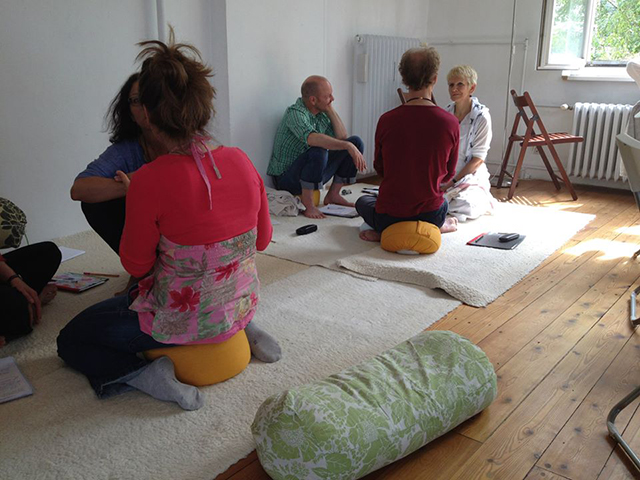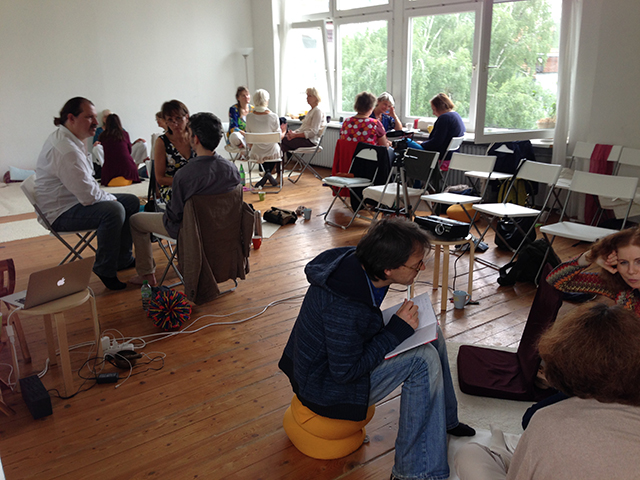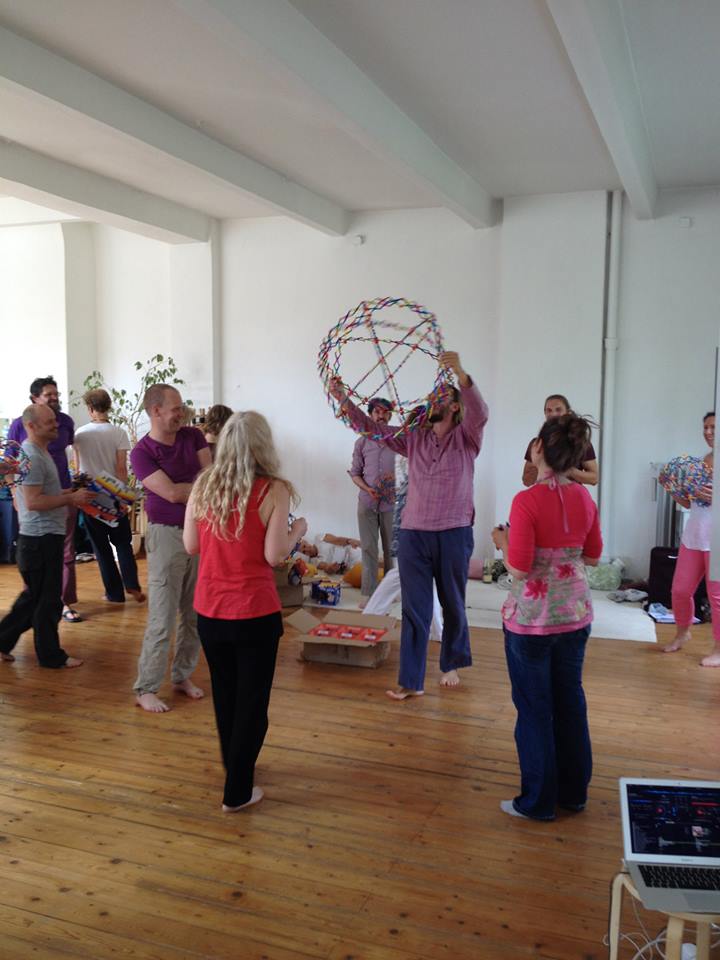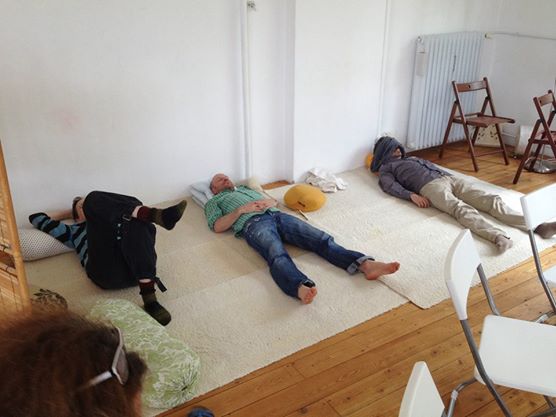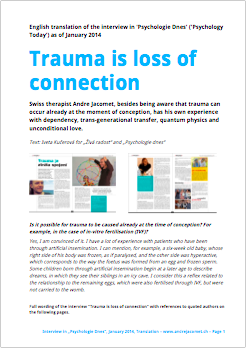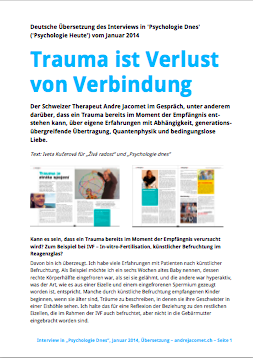In my Boulder Baby “Clinics,” which usually occur about once a month, we invite babies and their parents to join our staff for a four-hour period. We take turns focusing on one child and his or her family for about an hour and then move on to the next family. During the course of the last few years, we have seen babies of many ages, from newborns to five-year olds. We have worked with adopted babies, babies who have had traumatic births or elaborate surgeries, babies delivered by cesarean section, babies conceived by in vitro fertilization (IVF), and developmentally delayed babies.
In this format I have two assistants. One is a certified advanced Rolfer who is well trained in attending to the human body with various disciplines, including Craniosacral work. Her role is to monitor the somatic expressions of the babies, to assist me in making physical contact, and even sometimes to do a little cranial work. My other assistant is a parenting coach. Her role is to observe the baby and parents with the intention of monitoring their feelings, a job we call “The Empath.” Both assistants have been students of mine for several years, and thus have an orientation toward pre- and perinatal influences on children’s lives. To complete our staff, a daycare provider plays with the babies when it is not their turn to be the focus of attention.
One aspect of our format that contributes to the dynamic fiber of the families is that parents share quite a lot among each other. It is always wonderful and informative for us to hear what parents think and feel about their babies, how their babies are growing, and what kinds of challenges they are having. Additionally, it is productive and reassuring to the parents when they can hear from each other about how they deal with challenges they have in common.
When possible, we aim to have babies with similar histories or stories grouped together on a clinic day. For example, we might organize a morning session with four adopted babies. Another session might be comprised of babies who were all born by cesarean section. In this way parents with similar experiences can bond and share their ideas. The cases I describe here are of clients with IVF-conceived children from my private practice, who also came to the clinic. The combination of private work and group experiences has proven to be an excellent support for many families.
In my practice, I have had the opportunity to work with four pairs of twins of different ages who were all IVF conceptions. I saw four babies for four years, meeting them as young babies, and the other four were older when I met them. The oldest set of twins was eight years old.
It should be noted that all IVF babies are intensely monitored and manipulated throughout their embodiment process; from pre-conception to birth they are handled, examined, and assessed. Nearly all IVF babies are born by cesarean section. Most are twins, as multiple fertilized eggs are implanted in the uterus with the assumption that not all will live. The excess fertilized eggs are then frozen and saved at the lab. These are just a few of the processes that all IVF babies go through. (There are many reasons for this complex and often invasive scrutiny and handling. Many physicians and technologists may have a sincere desire to help infertile couples, but I suspect that part of the motivation is that IVF labs want to report higher and higher success rates when advertising to prospective parents.)
IVF babies seem to me (in my limited experience) to have some things in common which I don’t recognize in any other babies or children who might be classified into a group based on birth or surgical experiences (e.g. emergency cesarean babies, or cross-culturally adopted babies). In general, they need help finding structure, need help “finding their bodies” and need support in feeling safe with their emotions. These background traits will hopefully be illustrated in the examples below, along with some more individualized issues and dynamics.
One unusual and unexpected characteristic that almost all of these children had in common was that they had some sort of relationship to the fertilized eggs which (or should I say who?) were not used in the implantation and are now frozen. None of the IVF families I worked with had decided what to do with the frozen eggs. The various options include: implanting them in the mother in an attempt to have more children; donating them for stem cell research; disposing of them; or keeping them in frozen limbo. All of the parents were undergoing considerable struggle in coming to terms with what to do with these eggs, and none of them wanted to have any more children. One described how the eggs were “just eggs” when they were implanted, but once they had had children from them, the eggs seemed to take on a bigger significance. I do not know whether this issue is routinely discussed with parents who are in the early counseling stages prior to proceeding with IVF attempts. However, I feel it is ethically significant and should be discussed with potential parents, because all of the parents in my practice were and are really struggling with what choice to make.
The ways in which the IVF-conceived babies seemed to have relationships with the “non-present” brothers and sisters varied. A one-year old twin in one of the families, a girl who was able to stand and was beginning to say a few wonderful first words, had a consistent behavior pattern of looking up and to her left. After each instance of looking in this direction, she had a very distinct and sad expression on her face and in her eyes. Both the parents and I concurred that her expression was one of longing. Her behavior with this “looking” process was consistent and obvious, so the parents and I agreed that it might be something to work with.
We realized that the only time she did this “looking” behavior was when she was standing. In one session I tried holding different objects in the area where she appeared to be looking to see if there would be a response. First I held a small rubber ball with little bumps all over it, but she seemed to be looking beyond the ball. Then I held a picture book in the area she was looking, and both the parents and I agreed that she seemed to be engaging in the process with me, but also seemed to be looking through, or beyond, the book. Suddenly I got the idea that she could be experiencing something to do with her conception, and furthermore something to do with the unimplanted, fertilized eggs from her IVF process.
Responding to this impulse, I selected two small, naked, baby dolls. When she saw me choosing these dolls she began to have feelings and tremble a little. Checking in with the parents through eye contact, we all acknowledged that something significant was happening. When I brought the dolls up to the area where I assessed she had been looking, she trembled more significantly, burst into tears, and ran to her parents who held her with empathy. It was clear, by the look in her eyes, that she was processing something very deep, and that through the empathy with her parents, a healing process was going on.
In the debriefing portion at the end of the session, I was reluctant to bring up the idea that maybe the girl was seeing or feeling something to do with her conceived, but unimplanted, non-present siblings. IVF parents can be very sensitive about the whole process they have undertaken to have children. Often there is shame held at many levels: shame that they could not conceive naturally; shame because of the constant and sometimes invasive medical scrutiny; shame around the disposition of the remaining fertilized eggs; and shame about not being able to deliver vaginally. I rarely make references to the frozen embryos or ask questions about them unless the parents initiate the discussion. In this case, both parents began crying and explained that recently they had been talking together about the possibility that their daughter had been “looking for her siblings.” (They assured me that these discussions had not happened while the children were within earshot.) Although I had worked with them for some time, and they professed great trust in me and felt safe in our work together, they explained that they had been shy to tell me what they felt the behavior signified. This session helped bring the child’s and parents’ feelings out into the open in a safe and accurately empathic environment.
Now I want to describe an even clearer experience relevant to an IVF baby’s relationship to her frozen siblings. This comes from a very dear and loving family whom I had worked with over a period of four years. Both parents were extremely conscious, loving, and respectful of their babies, a boy and a girl. The daughter began to have significant dreams near the end of our four years of working together. These dreams started after several sessions that were designed to help the children feel resolution from traumatic aspects of their conception, which was through Intracytoplasmic Sperm Injection (ICSI). ICSI conception involves using donor eggs. The sperm of the father are centrifuged to collect the biggest ones. These are then injected into the donor eggs, and the resulting fertilized eggs are implanted into the mother.
These parents made a point of spending time with their children each morning, and we had often talked together in sessions about dreams the children had had over the years. In this particular session, the parents were quite stimulated and asked for some time without the children. The mother explained to me that her daughter had been very upset over a dream and had asked to be held for a long time that morning. When the mother asked her to share what she wanted, the girl replied, “We have to do something about my brothers and sisters.” She then explained, “ I have five brothers and three sisters.” The mother then told me that there were seven remaining embryos. The math works out, considering that the living twin is one of the siblings, while the frozen ones are the others. Then the girl went on to say, “My other brothers and sisters are freezing. They are in a cave in the snow and they are crying. We have to do something about them.” What can you say about an experience like this? I feel that it certainly deserves serious reflection.
One striking observation I have made with the several IVF cases I have worked with is that all of them have had a particular kind of disconnection from their bodies. The best way, although perhaps not the most scientific way, to describe this phenomenon is that the babies and children seem to have difficulty being grounded, organized, and relaxed in their bodies. I might even go so far as to say that, in my own subjective perception, sometimes they even seem to have a hard time “finding” their bodies. By this I mean something quite different from, for example, the relationship that children with cerebral palsy (CP) have with their bodies. CP children seem to have a dense quality, both neurologically and physiologically, while IVF children seem to have the opposite. I would describe it as an airiness, or thinness in the connection between the physical system and the person inside. Or perhaps it could be described as a disharmony between “themselves” and their bodies. The IVF children I’ve met and worked with seem to have a tentative relationship to structure and form, including to the very structure of their own bodies.
I think one of the best ways to illustrate what I’m talking about is to describe an experience we had on an afternoon when we were working with four children from three families. All of the children were born by cesarean delivery. Two of them were conceived naturally, while the other two were conceived by IVF. One of the processes we use to work with cesarean babies involves creating a tunnel or a “gauntlet” intended to represent the birth canal through which they might have been (but were not) born. The tunnel is created by the parents and assistants organized into two rows, with an “outlet” at the end. Usually the outlet is made from two chairs with blankets draped between them, so there is a hole in the middle through which the baby emerges to meet the mother waiting on the other side. The idea here is to organize a symbolic birth canal with the intention of encouraging the baby to experience and understand a little of what it might have been like to go through a vaginal birth, rather than being pulled out of the uterus. William Emerson and others have successfully used this technique for the resolution of trauma resulting from cesarean births.
We asked each child (between three and four years old and therefore old enough to comprehend games and simple instructions) to start at the open (uterine) end of the tunnel and then crawl or wiggle down the tunnel (vagina). The last stage was to go out the blanket end to meet the mother. The first two babies to go were the naturally conceived cesarean babies. They were encouraged and touched by the parents and assistants who formed the birth canal. Parents were saying things like, “You can do it!” and, “Go that way; mommy is on the other side!” Both of these first babies became activated (showed signs of stress) during the process; they stalled, struggled (although there was no physical impediment preventing them moving forward), and tried to go out the side of the tunnel. This attempt at a “sideways exit” is very common with almost all of the cesarean babies I have seen doing the exercise, especially when it is new to them. It is a direct recapitulation of their actual cesarean births. Eventually, both of these babies (going one at a time, while the other three were playing in the daycare area) managed to crawl down the simulated birth canal, go through the blanket, and meet their mothers.
Then it was time for the next child to go. One of the IVF children, when instructed to go to the open (uterine) end of the tunnel laughed, entered the tunnel from the side, pushed his way out the other side at a perpendicular angle and then went around the chairs (vaginal end) and hugged his mother. His sister, the other IVF /cesarean baby, was watching from the daycare area. She saw her brother happily participating in our game and then believed she had permission to enter the game herself. She was asked to go to the end of the tunnel but she wove her way randomly in and out of the tunnel and around the chairs to her mother. Both toddlers, apparently believing they were playing the same game the first two had, moved peripatetically and randomly around the parents and assistants who were maintaining the tunnel structure. No amount of explaining of the rules by the father could organize the children into our version of the game. These two children normally understand and follow instructions (sometimes with a little negotiation). Finally the slightly frustrated father gave up and, wanting his son and daughter to have the experience of going through the birth tunnel, asked if he could pick one up and put him at the open end. We agreed and rearranged the tunnel so the father was at the uterine end. He placed his son at the end of the tunnel and practically begged him to go down the tunnel, through the blanket, and out the other side to his mom. The boy jumped up and down and began chasing his sister who was running in and out of the tunnel.
We finally gave up on the idea of having these two children try this game, because we realized it would have taken too much directivity. They just could not naturally follow the instructions. I have not had a chance to repeat the exercise with other IVF children, but I would not be surprised if the results are similar.
IVF children, like all other children, can be beautiful human beings and tender souls, and I really love the ones I have worked with and known well. I can say that in some ways, especially when concerned with structure, form, and their personal relationships with their bodies, the IVF children I have met have experienced some extra frustration and so have their parents. In my limited experience, IVF children seem to need a little extra attention in some areas. If my observations can be generalized to the larger IVF population, it could be said that IVF babies may not always be the “little bundles of joy” their parents are hoping for. Additionally, IVF babies often come as twins, which increases childcare demands upon already stressed parents. The parents of IVF babies have already been through a lot, sometimes trying to conceive for years before resorting to the IVF process, which is expensive and rigorous.
I am concerned that IVF technology has advanced well beyond our understanding of the psychological impacts of the procedure. Parents having difficulty conceiving would be well served by a serious study of the psychological and physiological tendencies in IVF children. They could then be more fully advised in advance of a decision involving a large financial expenditure, significant gestational stress for the mother and baby, as well as (almost always) a cesarean delivery and a sudden doubling of the family size.
I don’t know if the characteristics I have observed are present in all or many of the IVF children in the general population, and I have not heard of any studies done in this area. I don’t know how relevant this is to the IVF culture that is being created and is rapidly growing. I do know that these tendencies have had a real and evident effect on all the families I have worked with, and I am concerned about the increasing popularity of IVF conceptions that do not include attention to this level of awareness.
Interestingly, two of my families (50%), after a great deal of personal work with their babies, which obviously has a profound affect on the parents, unintentionally and to their surprise conceived and delivered a baby naturally. It seems that something shifted in the parents during the process of working so deeply and empathically with their IVF children.
– Karlton Terry, Pre & Perinatal Educator, Denver, Colorado
Parents wishing to conceive by IVF or who have IVF children who wish to speak with Karlton Terry or his assistants may call Karlton’s administrative assistant, Tia Leftin, at 303-832-1117 to arrange a consultation.

















